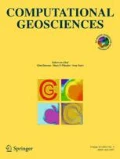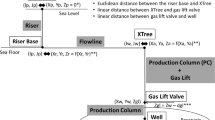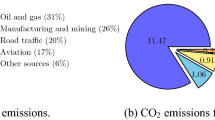Abstract
Many model-based techniques for optimizing hydrocarbon production, especially robust optimization (RO), carry prohibitive computational cost. Ensemble-based optimization (EnOpt) is a promising RO method but is computationally intensive when based on rich grid-based reservoir models with hundreds of realizations. We present a proxy-model workflow where a grid-based model is supplemented by a useful yet tractable proxy model. A capacitance-resistance model (CRM) can be a proxy model for waterflooding systems. We illustrate the use of CRM-based models and investigate their pros and cons using synthetic 2D and 3D models. A selected proxy model is embedded into the proxy-model workflow. The results obtained from the proxy-model and traditional workflows are compared. The impact of any differences is assessed by considering a relevant decision-making context. The main contributions are (1) a general RO workflow that embeds proxy models, (2) a discussion of the desiderata of proxy models, (3) illustration and discussion of the use of CRM-based models in the proxy-model workflow, and (4) a discussion of the impact of using a proxy model for production optimization in a decision-making context. Based on our study, we conclude that CRM-based models have high potential to serve as a cogent proxy model for waterflooding related decision-making context and that the proxy-model workflow, leveraging a faster, but relevant, production model, significantly speeds up the optimization yet gives robust results that leads to a near-optimal solution.
Similar content being viewed by others
References
Albertoni, A., Lake, L.W.: Inferring interwell connectivity only from well-rate fluctuations in waterfloods. SPE Reserv. Eval. Eng. 6(1), 6–16 (2003)
Al-Najem, A.A., Siddiqui, S., Soliman, M., Yuen, B.: Streamline Simulation Technology: Evolution and Recent Trends. Paper SPE-160894-MS Presented at the SPE Saudi Arabia Section Technical Symposium and Exhibition, Al-Khobar, Saudi Arabia (2012)
Alghareeb, Z.M., Williams, J.: Optimum Decision-Making in Reservoir Management Using Reduced-Order Models. Paper SPE-166305-MS Presented at the SPE Annual Technical Conference and Exhibition, New Orleans, Louisiana, USA (2013)
Borg, I., Groenen, P.J.: Modern Multidimensional Scaling: Theory and Applications. Springer Science & Business Media, New York, USA (2005)
Box, G.E.P.: Robustness in the strategy of scientific model building. Robustness in Statistics, 201–236 (1979)
Bratvold, R.B., Begg, S.: Making Good Decisions. Society of Petroleum Engineers, Texas, USA (2010)
Bratvold, R.B., Begg, S.: Would you know a good decision if you saw one? The Way Ahead 5(2), 21–23 (2009)
Bratvold, R.B., Bickel, J.E., Lohne, H.P.: Value of information in the oil and gas industry: past, present, and future. SPE Reserv. Eval. Eng. 12(4), 630–638 (2009)
Bruce, W.A.: An electrical device for analyzing oil-reservoir behavior. Pet. Technol. 151(1), 112–124 (1943)
Cao, F.: Development of a Two-phase Flow Coupled Capacitance Resistance Model. PhD Dissertation, The University of Texas at Austin, USA (2014)
Cao, F., Luo, H., Lake, L.W.: Development of a Fully Coupled Two-Phase Flow Based Capacitance Resistance Model (CRM). Paper SPE-169485-MS Presented at the SPE Improved Oil Recovery Symposium, Tulsa, Oklahoma, USA (2014)
Cao, F., Luo, H., Lake, L.W.: Oil-rate forecast by inferring fractional-flow models from field data with Koval method combined with the capacitance/resistance model. SPE Reserv. Eval. Eng. 18(4), 534–553 (2015)
Chen, Y., Oliver, D.S., Zhang, D.: Efficient ensemble-based closed- loop production optimization. SPE J. 14(4), 634–645 (2009)
Denney, D.: Pros and cons of applying a proxy model as a substitute for full reservoir simulations. J. Petrol. Tech. 62(7), 634–645 (2010)
Do, S.T., Reynolds, A.C.: Theoretical connections between optimization algorithms based on an approximate gradient. Comput. Geosci. 1717(6), 959–973 (2013)
ECLIPSE: http://www.software.slb.com/products/eclipse. Accessed 12 October 2016 (2014)
Fonseca, R., Stordal, A., Leeuwenburgh, O., Van den Hof, P.M.J., Jansen, J.D.: Robust Ensemble-Based Multi-Objective Optimization. ECMOR XIV-14Th European Conference on the Mathematics of Oil Recovery, Catania, Sicily, Italy (2014)
Gentil, P.H.: The Use of Multilinear Regression Models in Patterned Waterfloods: Physical Meaning of the Regression Coefficients. Master’s thesis, The University of Texas at Austin, USA (2005)
Holanda, R.W., Gildin, E., Jensen, J.L.: Improved Waterflood Analysis Using the Capacitance-Resistance Model within a Control Systems Framework. Paper SPE-177106-MS Presented at SPE Latin American and Caribbean Petroleum Engineering Conference, Quito, Ecuador (2015)
Izgec, O., Kabir, C.S.: Quantifying nonuniform aquifer strength at individual wells. SPE Reserv. Eval. Eng. 13(2), 296–305 (2010)
Jafroodi, N., Zhang, D.: New method for reservoir characterization and optimization using CRM-EnOpt approach. J. Pet. Sci. Eng. 77(2), 155–171 (2011)
Koval, E.: A method for predicting the performance of unstable miscible displacement in heterogeneous media. Soc. Pet. Eng. J. 3(2), 145–154 (1963)
Lake, L.W.: Enhanced Oil Recovery. Prentice Hall, Englewood Cliffs, New Jersey, USA (1989)
Liang, X., Weber, D., Edgar, T.F., Lake, L.W., Sayarpour, M., Yousef, A.A.: Optimization of Oil Production based on a Capa- citance Model of Production and Injection Rates. Paper SPE-107713-MS presented at the Hydrocarbon Economics and Evaluation Symposium, Dallas, Texas, USA (2007)
MATLAB: http://se.mathworks.com/products/matlab. Accessed 12 October 2016 (2014)
Nocedal, J., Wright, S.: Numerical Optimization, pp. 56–57. Springer Science & Business Media, New York, USA (2006)
Sayarpour, M.: Development and Application of Capacitance-Resistive Models to Water/CO2 Floods. PhD Dissertation, The University of Texas at Austin, USA (2008)
Sayarpour, M., Kabir, C., Sepehrnoori, K., Lake, L.W.: Probabilistic history matching with the capacitance-resistance model in waterfloods: a precursor to numerical modeling. J. Pet. Sci. Eng. 78(1), 96–108 (2011)
Stordal, A.S., Szklarz, S., Leeuwenburgh, O.: A theoretical look at ensemble-based optimization in reservoir management. Math. Geosci. 48(4), 399–417 (2015)
Sayarpour, M., Zuluaga, E., Kabir, C.S., Lake, L.W.: The use of capacitance-resistance models for rapid estimation of waterflood performance and optimization. J. Pet. Sci. Eng. 69(3–4), 227–238 (2009)
Tavassoli, Z., Carter, J.N., King, P.R.: Errors in history matching. SPE J. 9(3), 352–361 (2004)
Vakili-Ghahani, S.A., Jansen, J.D.: A system-theoretical approach to selective grid coarsening of reservoir models. Comput. Geosci. 16(1), 159–176 (2012)
van Essen, G.M., Zandvliet, M.J., Van den Hof, P.M.J., Bosgra, O.H., Jansen, J.D.: Robust waterflooding optimization of multiple geological scenarios. SPE J. 14(1), 202–210 (2009)
Welge, H.J.: A simplified method for computing oil recovery by gas or water drive. J. Petrol. Tech. 4(4), 91–98 (1952)
Yang, C., Card, C., Nghiem, L.X., Fedutenko, E.: Robust Optimization of SAGD Operations under Geological Uncertainties. Paper SPE-141676-MS Presented at the SPE Reservoir Simulation Symposium, The Woodlands, Texas, USA (2011)
Yousef, A.A., Gentil, P.H., Jensen, J.L., Lake, L.W.: A capacitance model to infer interwell connectivity from production and injection rate fluctuations. SPE Reserv. Eval. Eng. 9(6), 630–646 (2006)
Zhao, H., Kang, Z., Zhang, X., Sun, H., Cao, L., Reynolds, A.C.: INSIM: a Data-Driven Model for History Matching and Prediction for Waterflooding Monitoring and Management with a Field Application. Paper SPE-173213-MS Presented at the SPE Reservoir Simulation Symposium, Houston, Texas, USA (2015)
Acknowledgements
The authors acknowledge the Research Council of Norway and the industry partners; ConocoPhillips Skandinavia AS, Aker BP ASA, Eni Norge AS, Maersk Oil Norway AS, DONG Energy A/S, Denmark, Statoil Petroleum AS, ENGIE E&P NORGE AS, Lundin Norway AS, Halliburton AS, Schlumberger Norge AS, Wintershall Norge AS of The National IOR Centre of Norway for support.
Author information
Authors and Affiliations
Corresponding author
Rights and permissions
About this article
Cite this article
Hong, A.J., Bratvold, R.B. & Nævdal, G. Robust production optimization with capacitance-resistance model as precursor. Comput Geosci 21, 1423–1442 (2017). https://doi.org/10.1007/s10596-017-9666-8
Received:
Accepted:
Published:
Issue Date:
DOI: https://doi.org/10.1007/s10596-017-9666-8




